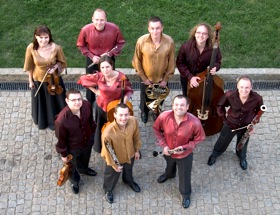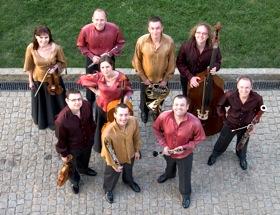California State University only seems to show up in the news nowadays in tales of budget cuts, tuition raises, deferred maintenance, and devastating program reductions. Fortunately, the May T. Morrison Artists Series of free chamber music concerts at San Francisco State University is protected by permanent endowment. On Sunday, the Czech Nonet opened the series’ 55th season, curated by a new artistic director, composer Ronald Caltabiano.

Put a composer in charge, and the result is bound to be some new music presented. The centerpiece of Sunday’s concert was a new work, Nonet, by the established American composer Daniel Asia (b. 1953), with whom the Czech Nonet shares a manager. A nonet is a work for nine performers, and the Czech Nonet is a standing ensemble founded in 1924 to perform a famous 1813 Nonet (for violin, viola, cello, contrabass, flute, oboe, clarinet, bassoon, and horn) by Louis Spohr. Given the need to expand the small repertory of works with this instrumentation, the Czech Nonet has commissioned more than 300 works over the years.
Asia’s new work comes in the form of six character movements, three of them very short (under a minute). His style reminds me of works by composers like Jacob Druckman or Gunther Schuller, whose best music explores structure, dissonant harmonies, and form through traditional playing styles. The shorter movements, though, did not make much sense to me, coming across as random microspasms of modernism. More successful were the longer, more flowing movements, especially the third slower movement and the finale. These played to both the Czech Nonet’s strength as a polished ensemble and to Asia’s idiomatic writing. Especially effective was the third movement’s use of muted strings and antiphonal interplay of small groups of instruments.
Regrettably, Asia’s new work was disadvantaged, in my ears, because it followed the justly famous Nonetto by Bohuslav Martinů (1890-1959). Written in the composer’s final year for the Czech Nonet, Martinů’s sublimely crafted and self-assured work embodies much of what could generally be said about many first-rate composers’ late styles: It relies on perfection of balance, pacing, and introspective expression rather than bold experimentation. As a calling card of this particular chamber ensemble, the audience would have been hard-pressed to hear a better performance of it.
The wind dominance of the ensemble rubbed off onto the ensemble’s string players. They tended to phrase with easier, more breathlike pauses than is ordinarily done. Also notable was the ensemble’s collective sense of rhythm and leadership. Most chamber music ensembles rely on physical bobbing from a leading violinist or pianist to keep time. The Czech musicians, by contrast, appeared much more reserved. The winds, especially, exhibited perfect balance, intonation, and attack.
Intriguing Juxtaposition
The unique instrumentation of a nonet can make it sound like a protochamber orchestra, and Martinů’s work can be, and has been, performed with beefier string sections. It is an instrumentation well-suited, however, to the neoclassical works in vogue at the time of the Czech Nonet’s founding. The pairing of two works on the second half of the concert — an archetypically neoclassical “Divertimento” by a minor composer, Iša Krejči (1904-1968), and a reduced version of Wagner’s Siegfried Idyll — caused me to recall Stravinsky’s 1939 exegesis, The Poetics of Music, wherein he excoriates Wagner’s affection for never-ending melody as “disordered” and called on performers to avoid expression.
There was still plenty of room for expression in Krejči’s work, especially in a lovely solo played by violist Vladimir Kroupa with full, rich tone. Krejči’s lighthearted piece had several audience members smirking with glee. The Nonet dirtied up its characteristic cleanliness and precision and revved up the vibratos a bit for the Wagner, so as to achieve more expression in “the perpetual becoming of music that never had any reason for starting, any more than it has any reason for ending,” as Stravinsky put it.
It was heartening to see a large audience (including many students) turn out for Sunday’s well-balanced, relevant, and brilliantly executed program. As free concerts go, this audience would have been hard-pressed to find a better deal in town.

